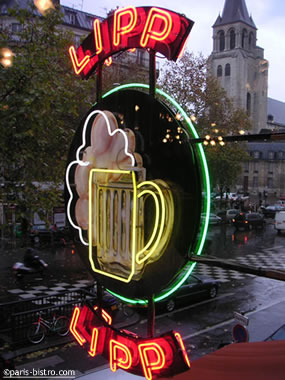Lipp is an integral part of French history. It’s a legendary place that has attracted Parisiens and tourists alike. It is, in itself, the center of the story of 20th century Paris, when Saint-Germain des Prés was at the top of the world in ideas and politics.

Lipp owes much of its glorious fame to its owners during 50 years, Marcellin and Roger Cazes.
He soon emigrated to Paris in 1880 and at 151 boulevard Saint-Germain, he created the Brasserie des Bords du Rhin, named after his beloved birthplace. He offered the local fare of his birthplace, such as sauerkraut and beer. For 25 years, Mr. Lipp built the reputation of his brasserie.
Then in 1918, Marcellin Cazes took over the business and changed the name from the Bords du Rhin to Brasserie Lipp.
More than anyone, Marcellin Cazes represented the people of Aveyron in Paris at the end of the 19th century. He was born in Laguiole in 1888, to a family of eight children, and set off for Paris when he was 14 years old.
Continue below
His brother, a retailer at Montmartre, put him up. Like many of his counterparts arrived from Auvergne and Aveyron. He carried coal, then became a bath-boy carrying up the stairs a tub as well as buckets of boiling water. The trick was to fill it without putting a drop on the floor. This is how a bath-boy could ensure himself a tip.
Cazes’ first foray into the café world was as a morning assistant in a café on the boulevard Poissonière. Three years later, he became a waiter at l’Electricité, near Faubourg-Montmartre. He spent 16 hours a day carrying trays and bottles, and little by little was able to save enough tip money to start his first business in the Cafés of Paris.
He bought his first business which he ran with his wife on the boulevard Voltaire near the Bastille. Then he set up in the Halle district. That’s where he survived the war in 1914.
Twice wounded, Marcellin was determined to stay in Paris. In 1920, at the age of 32, Marcellin dreamed of Paris as it was before the war. He took out a large loan and crossed the Seine to purchase a beautiful café on the boulevard Saint-Germain des Prés. A place that had only ten tables and false walls. This was Lipp’s café.
At Lipp’s, his wife took care of the cooking. The house was known for its sauerkraut and other Alsacian dishes, so there was no point in changing a formula that works. Marcelllin’s job was to create an atmosphere. He meticulously selected the staff as well as the customers.
The café was in a prime location: the nearby theatre group of the Vieux-Colombier came to Lipp’s every evening with the famous French actor Louis Jouvet. In 1925, Marcellin expanded the place to suit its increasing clientele.
Continue
Many actors have stopped by Lipp’s as well as writers like the pilot Saint-Exupéry. He, along with fellow author, André Malraux, celebrated his claiming of the Goncourt prize at Lipp in 1933. Politicians, especially foreign ministers, also became regulars. From the right wing to the left, they avoided each other’s gaze even though the sauerkraut they were eating came from the same pot. Marcellin Cazes made sure his customers were heartily well-fed. The kitchen was always a mad scene and you had to take turns at the beer pump.
In 1934 one of Lipp’s customers suggested to Cazes to create a book prize, which still exists today, Le prix Cazes. It is a literary prize which keeps a little reputation even though the conditions are not followed for example the authors must be young, which is sometimes not the case.
During the second world war and occupation, Lipp could have been visited by SS officers, members of the French gestapo, or rich art dealers that plundered Jewish property. But Cazes would have nothing to do with them, and preferred to serve beer to writers who refused to collaborate. On the day of the liberation of Paris, Cazes bought champagne for his customers. Some days later, a war correspondant from the US army stopped in at the brasserie. It was Ernest Hemingway, who had his glass of cognac filled by a very happy Cazes.
In the 1950s, his son, Roger Cazes, took over Lipp’s. It became a great parliamentary meeting place. The parties of the time—the MRP, radicals, and socialists—all shared the same space. Sometimes to bring back calm and order into the room, the boss would ring a bell.
The bell was silenced for many years but was brought back out the evening of the May 10, 1981 with the election of François Mitterrand. That evening, the brasserie was transformed into a madhouse. As each well-known political face entered the place, one side applauded while the other side booed, according to the new arrival’s political affiliation.